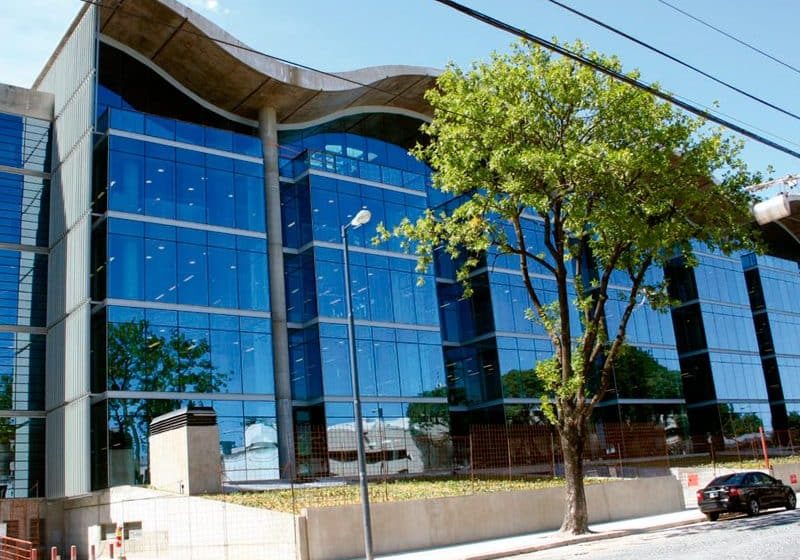United States Looking Up
Sep 1, 2015

Construction, including that of skyscrapers and infrastructure, is expected to gain momentum through 2015 and hold steady in 2016, and elevator companies are reaping the rewards.
From coast to coast, in major U.S. cities and smaller towns, construction is on the rise. Skyscrapers housing offices, hotels and retail are going up, and vertical-transportation companies are reaping the rewards. Analysts expect the trend to gain momentum for the rest of 2015 and construction to remain strong, yet more balanced, through 2016. OEMs report steady work. Independent elevator contractors, although facing challenges, are generally optimistic (see sidebar). Kermit Baker, chief economist for The American Institute of Architects (AIA), observes:
“Expect the second half of 2015, as well as 2016, to be positive for construction activity. Spending on nonresidential building should total close to US$380 billion this year, approaching US$390 billion in 2016. That still would leave the industry more than 10% below its most recent high in 2008. However, if these forecasts are achieved, spending on nonresidential building would have increased over 25% between 2013 and 2016, putting the industry tantalizingly close to a full recovery from this past downturn.”
Growth in the institutional sector promises to balance out overall growth for 2015 into 2016, Baker says, with institutional construction spending increasing nearly 6% in 2016 – more than double than in 2015. According to the AIA, all nonresidential sectors are projected to see gains, with overall building spending up 9%, commercial activity up 12% and manufacturing up 22%. In 2016, nonresidential construction is expected to grow by 8%. AIA’s architectural billings for multifamily projects, which are an indicator of construction activity nine-12 months down the road, have been holding strong, although demand is slowing. Developers are still getting financing for projects, such as the luxury condo high rises, but slackening demand prompts one to wonder if this market is approaching a breaking point.
Elevator OEMs consider the U.S. market a cornerstone of their business, and a continuing influx of contracts promises to ensure it stays that way. Schindler, for example, says that in 2014, the U.S. emerged as the leader of its Americas division in terms of revenue and orders. The company, states Christopher Smith, director of Marketing and Communications, “experienced exceptional increases in orders received” in the U.S.
Markets including Chicago and New York represent the lion’s share of Schindler’s commercial office contracts, including new construction, maintenance and modernization. Projects in San Francisco, Philadelphia and Houston are also generating work for Schindler, which, in addition to commercial-building installation, is performing significant infrastructure work for such organizations as the Honolulu Authority for Rapid Transportation (HART). For that new public-transit project, Schindler is providing 49 custom machine-room-less traction elevators and 23 9700 transit escalators.
Domestic infrastructure projects are generating enough work to go around. KONE Americas recently embarked on the largest project in its history – modernization and replacement of 128 escalators and 34 elevators in Washington Metropolitan Area Transit Authority stations. KONE’s Patrick O’Connell recently spoke to ELEVATOR WORLD about some of the specifics of that project (EW, August 2015). It will keep Schindler employees busy through at least 2020.
KONE’s U.S. reach is pervasive, O’Connell observes, and includes large cities such as Chicago; New York; Boston; Dallas; Denver; Atlanta; San Francisco; Seattle; and Washington, D.C.; and midsize cities such as Indianapolis; Nashville, Tennessee; Kansas City, Missouri; Baltimore; and Austin, Texas. KONE was recently tapped to modernize historic 11 W. Madison Avenue in New York City (EW, April 2015) and to provide 14 elevators for a new office tower in Austin, 500 W. 2nd Street.
The Sky Is the Limit
Global skyscraper giant NYC is in the midst of a skyscraper boom, driven notably by ultra-high-end condos that are drawing the world’s attention. When it is completed in a few years, the 1,432-ft.-tall 432 Park Avenue will be the tallest residential building in the Western Hemisphere (EW, June 2015). Jason Barr, a Rutgers University-Newark professor who authored “The Economics of Skyscraper Construction in Manhattan” for the Council on Tall Buildings and Urban Habitat, says the fact that such buildings are going up means people are willing to pay a premium to live there. Elevators are a key part of the equation, he observes, continuing:
“While no research has studied the specific reasons for [people willing to pay more for property on higher floors], one would assume the height premium is driven first by the better views and lower street noise, and second by the social status it confers upon those who occupy space above the majority of the tenants. Being on a higher floor signals that one has more resources to pay for the right, and thus will occupy a more favorable position in the social or economic hierarchy. This height premium is based on the assumption that elevators are able to deliver people rapidly and comfortably to the upper floors.”
Few places is this more evident than in the Middle East, where KONE’s UltraRopeTM lightweight cable will lift elevators in the world’s future tallest tower, Kingdom Tower (EW, July 2015). Technology nearly always precedes demand, Barr observes, and it is only a matter of time before clients in NYC and other major U.S. cities demand technologies such as UltraRope, he says.
While Southeast Asia and the Middle East are “on a tear” in terms of skyscraper construction, the U.S. is no slouch, Barr notes. The years immediately following World War II were the heyday for skyscraper construction in NYC, Chicago and Los Angeles, but there are plenty of new ones in the works today, and they are much taller than their predecessors. NYC has at least seven luxury supertalls planned or under construction, housing condos affordable only for the world’s most wealthy.[1] A penthouse in NYC’s One57 sold earlier this year for more than US$100.5 million, setting a city record.[2]
Based on what’s been announced or already coming out of the ground, Manhattan’s luxury high-rise boom is forecast to continue at a steady pace for approximately the next six years, Barr states. Buyers are often international investors who appreciate the prestige of owning Manhattan real estate.[3]
One wonders if the ultra-luxury residential high-rise trend is sustainable. “Given the high prices for luxury condos, developers are rushing to complete as many of these types of buildings as possible,” Barr notes. “But, they will likely find they oversupplied the market, as there are only so many billionaires in the world.” Chances are, he said, some of the current plans will be scrapped or change directions if units don’t sell.
Elevators in the U.S. share certain characteristics, states Matt Watkins, executive vice president of marketing, ThyssenKrupp Americas, who observes elevators are typically larger in the U.S. due to developers having more space with which to work and comply with the Americans with Disabilities Act. Also, some AHJs in the U.S. do not allow installation of machine-room-less elevators, he says.
Still, U.S. customers are embracing new technology. Watkins says the number of mid- to high-rise gearless installations is increasing “significantly,” and the acceptance of destination-dispatch systems continues to grow.
Schindler concurs. Smith states that for its clients, “Schindler’s PORT technology is quickly becoming the standard in new-building dispatch and has emerged as a necessity to compete for contract awards.”
U.S. developers appear poised to take advantage of the latest installation methods, which are changing the way skyscrapers are being built. KONE’s JumpLift self-climbing elevator made its North American debut recently in One Bloor being built in downtown Toronto (EW, January 2015). JumpLift, O’Connell states, “cuts months off the construction schedule for a high-rise building and helps ensure the efficient flow of construction workers to get them safely to their work floors.”
Miami’s future tallest, the 822-ft.-tall, 81-story Panorama Tower, is looking to utilize a pair of Otis’ self-climbing jump lifts once construction reaches the 19th floor, according to Project Executive Leo Estrada of Tutor Perini Building Corp., who states:
“What this means is, we don’t have to wait until the building is topped off before we have a running car. [The jump lifts] will climb up the building in three-floor intervals until construction reaches the top. These cars will replace a dual-car materials hoist during construction. From my understanding, this will be the first time this system has been used in the U.S.”
In August, Panorama tower was approximately 20% complete. Also in Miami, the 60-story Porsche Design Tower is set to get unique elevators specially designed to lift owners’ automobiles directly to their doors.
NAEC Members Share Their Thoughts
Independents in the National Association of Elevator Contractors (NAEC) paint a mixed picture but remain generally optimistic.
“Kencor Inc.’s geographic area is the state of New Jersey, eastern Pennsylvania, Delaware and Maryland. New construction activity is largely municipal or federally funded. The apartment sector is still active. However, office, retail and industrial [are] not very active at the moment. Modernization activity is booming, especially in the metropolitan areas, mostly in housing. Our modernization bookings are up more than 25% over 2014. Maintenance and repair bookings are up more than 20% from 2014, and they continue to be strong in every geographic area we serve. Overall, we see moderate growth for the second half of 2015 and early 2016. Kencor will continue to expand and hire through 2015.” – Richard A. Kennedy, president and CEO, Kencor, West Chester, Pennsylvania
“We have seen steady growth in both commercial and residential business and have a strong forecast for the next eight months. That said, profit margins have been much tighter. The hope is that will improve with the Associated Builders & Contractors forecast of a reasonably brisk industry recovery in 2015 that is expected to continue into 2016.” – David Smarte, director of Safety & Education, Delaware Elevator (offices in Delaware, Maryland, Virginia, Minnesota, Pennsylvania and Florida)
“The Midwest has seen a consistent volume of custom residential elevator projects but not like in 2000-2007. There is some activity on multiunit projects, but not like in that same timeframe. The imposition of licensing and inspections will add cost to labor and potentially put residential elevators out of many project budgets. Labor inflation has begun, as an artificial US$15 minimum wage is already affecting starting employees’ mindsets. The vertical and inclined lift segment is rather fragmented, with many do-it-yourself online options that drive down the perceived value of code-compliant options. Further government regulations are driving smaller contractors out of business as business ownership becomes a daily battle with regulatory compliance versus running your business. Banks are not lending, and new oversight regulators are causing normal lending practices to be challenged, so lines of credit and mortgages are far more difficult to secure, even with perfect credit. I do not expect any increased activity until after 2016.” – Craig Jones, owner, Country Home Elevator, Brighton, Missouri
“Backlog is very good, business is strong and it appears it will stay very strong through at least the end of this year and into the first quarter of next year. There is a lot of business taking place in both the private and public sectors. Most all contractors are busy. Lead times and schedules are now becoming a bit of an issue due to manpower and timely delivery of equipment issues.” – Bret Abels, senior vice president, O’Keefe Elevator Co., Inc., Omaha, Nebraska
“We have a six-month backlog of work. The residential market is strong, and the commercial market is doing well. Modernizations are spotty. We are seeing more bidding for commercial elevators, so I predict next year will be a successful year for elevators.” – Joe McNally, chairman of the board, McNally Elevator, Kalamazoo, Michigan
References
[1] Vanity Fair, “Too Rich, Too Thin, Too Tall?,” (Goldberger, Paul); May 2014.
[2] nycurbed.com, “$100 Million One57 PH Officially Closes, Breaks NYC Record,” (Amato, Rowley); January 17, 2015.
[3] The New York Times, “Towers of Secrecy: Stream of Foreign Wealth Flows to Elite New York Real Estate,” (Story, Louise and Saul, Stephanie); February 7, 2015.
Get more of Elevator World. Sign up for our free e-newsletter.









